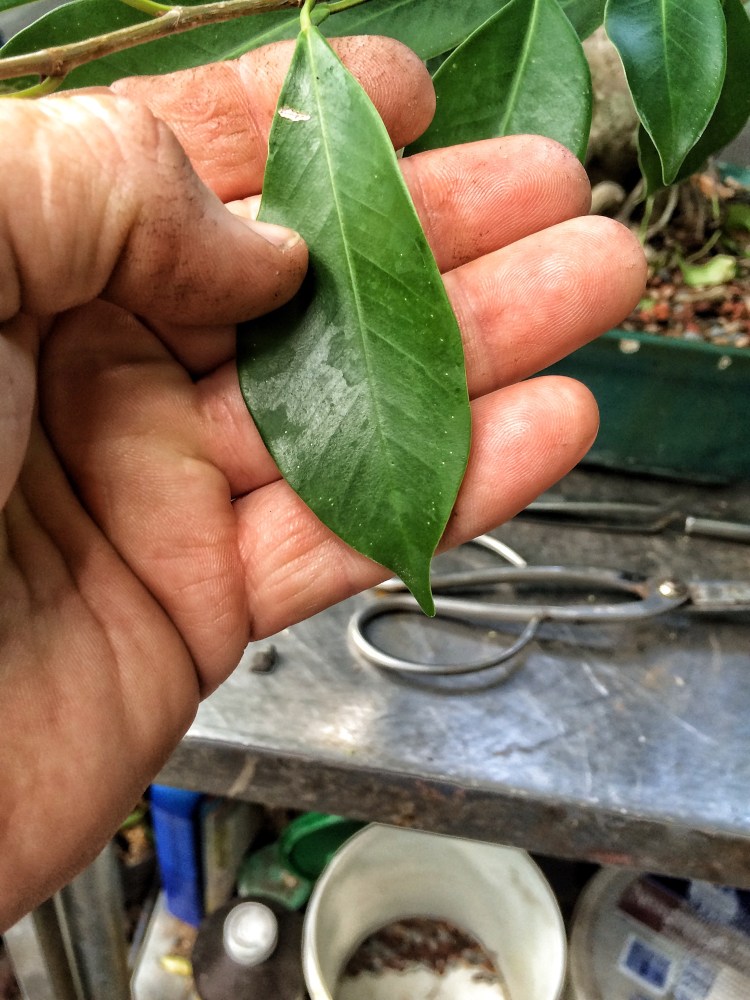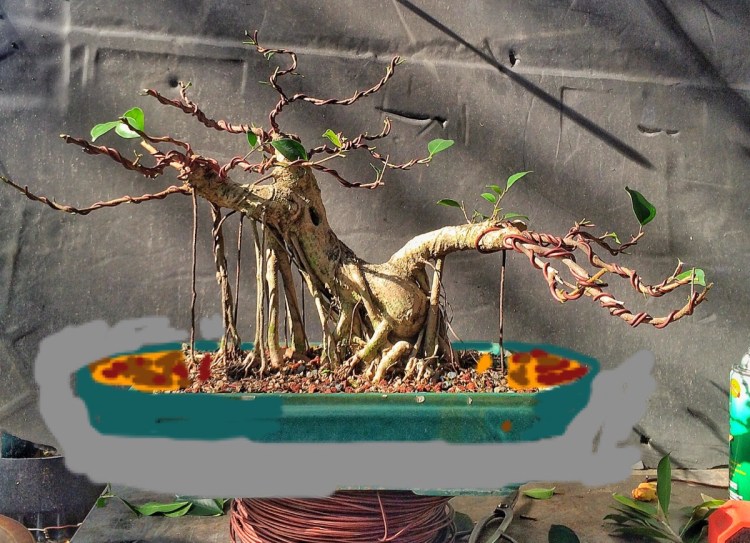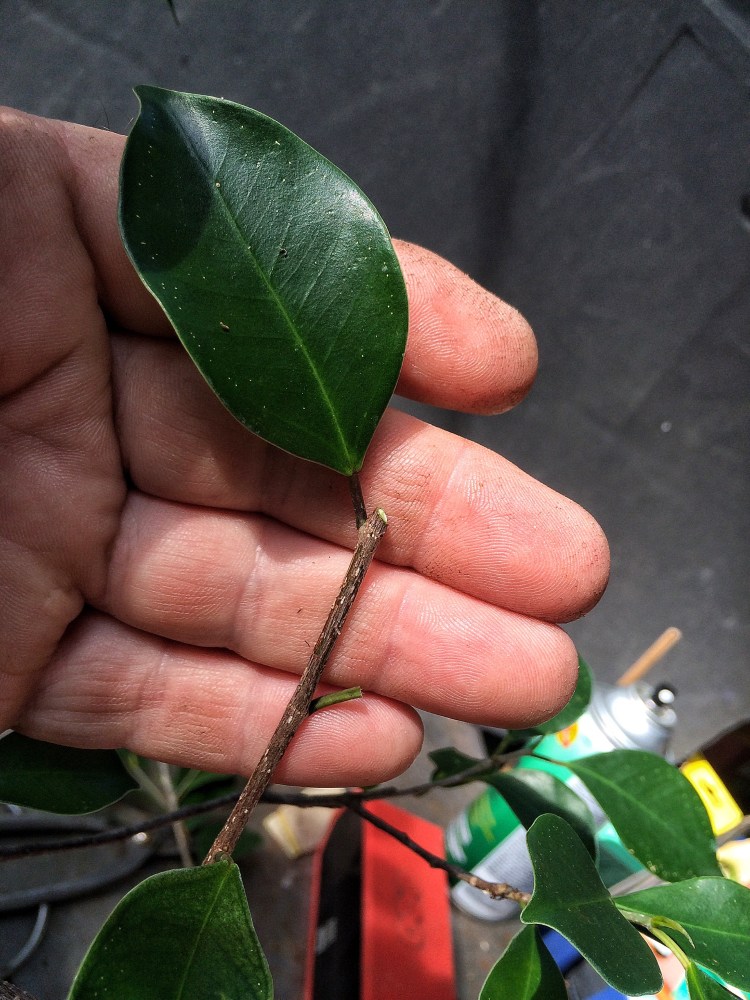I’m taking a break from the broad leaf and starting with some tropical bliss, which could be read a few different ways. But what it means is, are you ready for some ficus? How’s this for growth?
 Talk about huggie-branches, that one on the right was scratching my back. The one on the left is pretty long too.
Talk about huggie-branches, that one on the right was scratching my back. The one on the left is pretty long too.
 Reach out and touch someone (that used to be a telephone company’s slogan. Sounds kinda creepy nowadays). The tree is a ficus microcarpa.
Reach out and touch someone (that used to be a telephone company’s slogan. Sounds kinda creepy nowadays). The tree is a ficus microcarpa.  The leaf is about full size here. With proper cultivation, we can get the leaf size down to about the thickness of one of my fingers, or maybe a little more. I got the tree from my bud Ronn at a convention about three years ago (Blog post here)
The leaf is about full size here. With proper cultivation, we can get the leaf size down to about the thickness of one of my fingers, or maybe a little more. I got the tree from my bud Ronn at a convention about three years ago (Blog post here)
It has a nice trunk and that’s why I bought it.  Almost a classical banyan.
Almost a classical banyan.
One problem, though, is this excessive bit of negative space.  I’ll have to do a “comb over” to fill it in.
I’ll have to do a “comb over” to fill it in.

The tree has pushed new growth in all the right places, maybe too much in some. 
First order of business is to remove all those unwanted branches and then perform a partial defoliation (gasp! Oh the horror!).
Damn, I have a knick in these scissors. What did I cut?  Oh well, I’ll have to sharpen that out. Not now though. Too much work.
Oh well, I’ll have to sharpen that out. Not now though. Too much work.
Next, defoliation.  I understand that this method of development is suddenly being scrutinized by some of the young (or not so young) Bonsai Professional’s out there. This is what I have to say about it.
I understand that this method of development is suddenly being scrutinized by some of the young (or not so young) Bonsai Professional’s out there. This is what I have to say about it.
The horticulture supports both the idea of defoliating a tree to stimulate growth and by keeping the leaves on a tree to preserve strength and, therefore, stimulate growth. Let me explain.
The new thesis is that, by defoliating a tree, the tree then has to use energy to replace those leaves. (Think of a tree as an organic, solar energy collection unit). The tree only needs so many square inches of leaf surface to collect the solar output. If you suddenly remove all the leaves, the plant must replace those leaves as fast as it can because it cannot make new energy until it has new leaf surface to collect the Sun’s rays. If you only knew this about trees, one can extrapolate that removing leaves is a bad idea. It slows growth and stunts development. Right?
The antithesis is the idea that defoliation spurs new growth and develops a tree faster. At the base of the petiole (the branch’s stem) there is a dormant bud.  But, by removing that leaf, the new leaf will begin growing. This is the result of hormones that are doing nothing except waiting for some kind of vegetative change. Like trimming or, ah, defoliation. The trick to defoliating is you have to do it at the right time. With the ficus we are working on, defoliation is performed in the growing season. I’m doing it now (April first), but on last year’s leaves. The tree will respond with new, more efficient leaves very quickly. I’ll repeat that, last year’s leaves are not as efficient as new leaves might be. The reason is that they may have suffered damage (mechanical, cold, insect) or they are at the beginning the molting process anyway, meaning that the bond between the branch and the petiole is beginning to sever. Deciduous trees drop their leaves in the autumn and grow new ones in the spring. And then will drop them in the summer months (not all at once like in autumn but gradually depending on the available water and if the temperature causes heat dormancy) On broadleaf trees they will drop old leaves at the beginning of spring and, like the deciduous trees, again during heat dormancy. Hmmmmmn. Seems like these are the best times to defoliate too, according to the pro defoliation camp.
But, by removing that leaf, the new leaf will begin growing. This is the result of hormones that are doing nothing except waiting for some kind of vegetative change. Like trimming or, ah, defoliation. The trick to defoliating is you have to do it at the right time. With the ficus we are working on, defoliation is performed in the growing season. I’m doing it now (April first), but on last year’s leaves. The tree will respond with new, more efficient leaves very quickly. I’ll repeat that, last year’s leaves are not as efficient as new leaves might be. The reason is that they may have suffered damage (mechanical, cold, insect) or they are at the beginning the molting process anyway, meaning that the bond between the branch and the petiole is beginning to sever. Deciduous trees drop their leaves in the autumn and grow new ones in the spring. And then will drop them in the summer months (not all at once like in autumn but gradually depending on the available water and if the temperature causes heat dormancy) On broadleaf trees they will drop old leaves at the beginning of spring and, like the deciduous trees, again during heat dormancy. Hmmmmmn. Seems like these are the best times to defoliate too, according to the pro defoliation camp.
Other good times to defoliate? How about when repotting broadleaf evergreens? We do it then to reduce transpiration (how a plant moves water from bottom to top). Basically: there are holes in leaves (stomata) that water is expressed through and evaporates. When you cut roots (those organs which collect water) transpiration still happens. The tree will dry out faster without roots and, guess what, those leaves will fall off anyway. If you cut the leaves off as you repot, the tree doesn’t waste energy or water. There are exceptions to this like boxwood or dwarf jade, etc. but the general principle applies.
I could go on but to say that defoliation is a no-no is right and wrong.
I’m getting back to the tree.
When pruning our microcarpa, be a little more studious with your cuts.
 The cut above is plain sloppy. You’ll end up with a dead twig.
The cut above is plain sloppy. You’ll end up with a dead twig.
With all the talk of defoliating, I’m leaving a leaf (I crack myself up whenever I say that, sorry) on the terminal bud of each branch.  This will act like a siphon, pulling the energy up our branch and developing it quicker (it’s a hybrid methodology, which I do all the time, and if you don’t believe me, read back in the blog, you’ll see).
This will act like a siphon, pulling the energy up our branch and developing it quicker (it’s a hybrid methodology, which I do all the time, and if you don’t believe me, read back in the blog, you’ll see).
Now, wire.
 Here’s a quick course on anchoring multiple branches.
Here’s a quick course on anchoring multiple branches.
This branch could be wired with one big wire.  But, as we all should realize, a branch with multiple wire on it both is easier to bend and gives more support when bending, reducing the possibility of breakage. It’s not pretty, but it’s effective. And I have three more branches that need wire and, therefore, anchoring. So there’s three on this, the thickest branch. It’s the anchor branch.
But, as we all should realize, a branch with multiple wire on it both is easier to bend and gives more support when bending, reducing the possibility of breakage. It’s not pretty, but it’s effective. And I have three more branches that need wire and, therefore, anchoring. So there’s three on this, the thickest branch. It’s the anchor branch.
And, thirdly, from it: 
To this one here: 
And to reinforce the concept, I wired from this branch:

The one thing you need to learn is how many wires it takes to hold a branch after bending. That knowledge comes, ultimately, from experience and tactile manipulation of the branch. There are general rules of thumb but each tree, even each limb on the same tree, is different.
So, I figured out that the first branch needed at least three #3 wires to hold. It is an older branch and more stiff than the other branches, which only needed one wire, albeit they are maybe half the size. Ya’ dig? You need to get your hands on trees and start wiring and bending.
Speaking of which, the tree.


Ultimately, it will go in a shallower, wider pot.

And we are assuming that it will live, so, leaves.
The next tree on the chopping block is another ficus, exciting, ain’t it? And I’ll deal with those knocked scissors too.
Before I end the post, I have a few questions.
If I were to offer Skype-style training sessions, is there any interest? How about virtual stylings à la the above pic? Or even hand drawn sketches?
The reason I ask is that not everyone can afford to bring me in to their hometown for a private session (though I am still available for those) but would like some time with me. Skype, or FaceTime or something like that might just be the solution. Let me know what y’all think either in the comment section or send an email to adamaskwhy@att.net. Thanks!








Skype, FaceTime, whatever. I have trees and need help.
LikeLike
For some reason this tree reminds me of the T2 thrashing around in a pool of molten metal.
LikeLike
I probably wouldn’t do a FT and don’t have skype.
Do you have a dedicated forum style place to post comments or questions?
If you did then there could be sections dedicated to topics outside of specific blog posts like this current one.
I would ask for a photo or video detail of how you set wires in a new pot and then put them onto the tree to anchor it in the new pot. This is just an example of a specific topic discussion.
I would trust topics posted to a forum hosted by you more then I do on some of the others that I’ve checked into.
LikeLike
I’d pony up for a interactive session(s). I live in Siberia and have no access to a club or teachers beyond the internet so this would be very much appreciated. I’d even sweeten the deal by sending you some Michigan beers.
LikeLike
I would certainly be interested and via any interactive technology.
LikeLike
I live in reston va. Defolieated my south african ficus last year. Wanted to do it again this year. The weather has been awful. It is now June 11. Is it too late
LikeLike
It is a good time to do it, probably the best
LikeLike